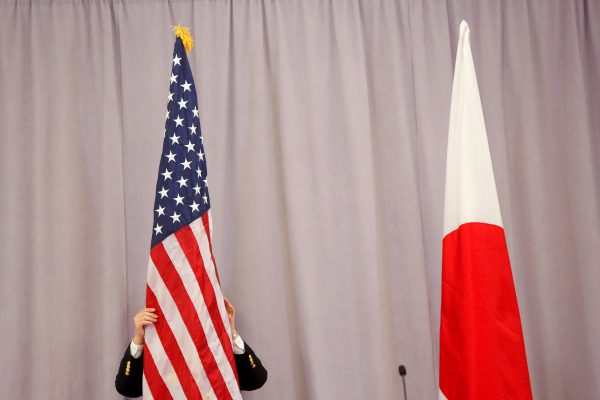Yet the region must find a way to work with the Trump presidency. Japanese Prime Minister Shinzo Abe signalled Japan’s intention to do so by becoming the first foreign leader to meet with President-elect Trump on 17 November. Looking ahead, the region faces a number of challenges that require intensive consultation and cooperation.
Trump’s ‘America First’ foreign policy rhetoric appears to be moving the United States away from its traditional role as a global leader at a time when the domestic and international political environments are undergoing significant change. Continued US leadership and intensive cooperation with allies and partners will remain critical to the maintenance of regional peace and prosperity.
While the Trump administration contemplates its foreign policy approach, America’s allies must review their regional approaches as well. Given that Japan remains the most important US ally in Asia, the two countries need to move forward and further build up the infrastructure of the alliance.
Japan has responded to the changing security environment with a remarkable suite of defence reforms aimed at expanding its ‘proactive contributions to peace’. Japan will need to continue to expand its contributions, but must do so in a way that is anchored by its identity as a peace-loving nation that does not use military means to pursue its economic or political agenda.
Given that Trump appears keen on having Japan expand its share of the security burden, the best option would be intensive US–Japan consultations that aim to forge a common approach to key challenges as an initial step toward a joint US–Japan strategy for the region. The overarching objective would be to retain and enhance US engagement in Asia while bolstering Japan’s security roles and functions within the alliance framework, and its contributions to peace, without opening a regionally destabilising Pandora’s box.
The Trump and Abe administrations should focus on four key areas.
First, a new approach towards North Korea is necessary. ‘Strategic patience’ has failed to change North Korean behaviour. The Kim Jong-un regime is edging closer to producing a miniaturised nuclear warhead that can be mounted on a long-range missile. This poses a serious threat.
Resolving the situation on the Korean peninsula requires comprehensive and coordinated efforts between the United States, Japan and South Korea to bring China into the fold. Beijing is still hesitant to apply crippling pressure to the extent that it would seriously undermine the Kim Jong-un regime’s political control and run the risk of causing North Korean collapse. The United States, South Korea and Japan must do more to reassure China that a full break with the regime in Pyongyang will not end up being antithetical to its national interests. This requires joint contingency planning among the allies as well as intensive discussions with China to prepare for worst-case scenarios on the peninsula.
Second, greater confidence-building among the United States, China, Russia, Japan and South Korea is sorely needed in order to de-escalate tensions, defuse nationalism and build relations rooted in win–win cooperation. While this may be hard to envision based on Trump’s election rhetoric, operational-level cooperation that is already underway between the United States, Japan and other likeminded countries in the region can gradually be expanded.
The third priority is nurturing a stable and inclusive regional order. On its current trajectory, the Asia-Pacific regional order risks fracturing into a two-tiered structure comprised of the US-led liberal international order and an emerging Chinese sphere of influence. The United States and Japan should prioritise engagement with China. They need to find some way to coordinate among regional institutions and advance functional cooperation among Asian powers.
Though the Trump administration is likely to place lower priority on international institutions, it is in the US interest to find some way to promote smoother coordination between the Asian Infrastructure Investment Bank and the One Belt, One Road initiative on the one hand and the IMF, World Bank and Asian Development Bank on the other.
Finally, the United States will need to find a balance between cooperation with Russia in areas of mutual interest and maintaining a unified front within the international community against unlawful Russian behaviour, such as its unilateral annexation of Crimea in March 2014. There is a strong need for intense consultations between Japan and the United States on this front.
There is a deep sense of uncertainty about the future role of the United States in East Asia. As Trump takes office, it will be crucial that his team makes a concerted effort to understand the positions of US allies and friends. As US domestic politics and the regional balance of power undergo changes, intensive consultations and cooperation with allies and partners will be critical. Forging a joint approach on key regional challenges in a way that opens the door to a shared US–Japan strategy will benefit both countries.
Hitoshi Tanaka is a senior fellow at the Japan Center for International Exchange and chairman of the Institute for International Strategy at the Japan Research Institute, Ltd. He previously served as Japan’s deputy minister for foreign affairs.
This article is an extract from East Asia Insights Vol. 11 No. 3 December 2016, which is available in full here, and is reprinted with the kind permission of JCIE.


It seems to me that there is an inherent contradiction between trying to deescalate tensions and work towards win-win cooperation with Russia while still maintaining a united front against unlawful behavior by Russia. If the USA and its Western/Asian allies refuse to abide by such things as the annexation of Crimea or Russia’s interference in eastern Ukraine how can tensions be lowered? I suspect the only ‘win-win cooperation’ that Putin will accept is when things are solely on his terms. Reciprocity is not something that he arrives to achieve.